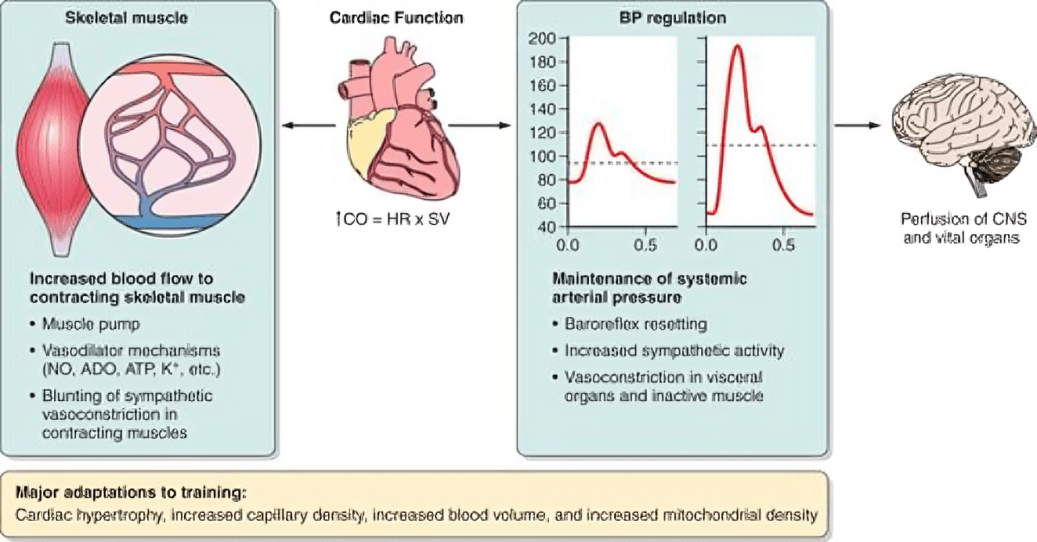
“
The importance of warm-up & cool-down begins with activation. A warm-up gradually elevates your heart rate, increases blood flow to muscles, and wakes up the nervous system, turning your body into a well-oiled machine, ready to move. On the other hand, the importance of warm-up & cool-down also involves winding down—cooling the system, slowing the pulse, and resetting breathing patterns, which is crucial in preventing stiffness and promoting flexibility. 1
”
A well-executed warm-up raises heart rate and breathing, supplying oxygen to your muscles. This shift prepares your cardiovascular system for exertion, helping your body perform better while significantly reducing the chances of muscle fatigue and injury. 1
Increasing the internal temperature of muscles through warm-up exercises makes them elastic and responsive. This enhanced muscle function reduces the risk of pulling or tearing tissues during intense movement. 2
A proper cool-down gently brings an elevated heart rate and blood pressure back to normal. This transition helps avoid dizziness or blood pooling in your limbs, ensuring your circulatory system safely adjusts to a resting state.3

Stretching after exercise during cool-down promotes muscle flexibility and removes lactic acid. This process helps minimize next-day soreness, keeping muscles from becoming stiff and enabling quicker recovery after resistance or cardio-based sessions.
Dynamic warm-ups like arm swings, walking lunges, and high knees activate joints and muscles. They mimic upcoming movements and signal your body to prepare for stress, improving motion efficiency and overall functional joint mobility. 4
Warm-ups aren’t just physical preparation; they mentally engage you. This mental readiness sharpens reflexes, reaction time, and performance, especially during competitive or goal-driven workouts. 5
A proper cool-down allows blood to pump rapidly during exercise and to return gradually. It prevents dizziness or fainting that might occur from sudden stops and helps maintain healthy blood circulation and a safe, controlled heart rhythm.6
Muscles contract rapidly during workouts, leading to tightness. Stretching during cool-down eases this tension and realigns fibers. It also prevents the shortening of muscles over time, which could otherwise reduce your natural range of motion. 7
Gradual warm-up exercises prevent abrupt stress on ligaments, tendons, and joints. This steady increase in workload prepares connective tissues for movement, which is essential for athletes who depend on long-term joint integrity and stability. 8
Cooling down improves venous return—the movement of blood back to the heart. Gentle movements assist circulation, especially from your legs, preventing blood from pooling in extremities and helping avoid swelling, cramping, or post-exercise fatigue in the body. 9

Active warm-ups enhance oxygen delivery to working muscles. It activates energy systems like ATP production, helping cells burn fuel efficiently, improving stamina and coordination, and reducing early muscle fatigue during the main workout.
Stretching in the cool-down period helps restore muscle length. During intense exercise, muscles shorten; cool-down stretches elongate them again, maintaining your body’s natural posture, which is especially beneficial if you work a sedentary job.10
Starting exercise without warming up can shock the cardiovascular system. A cold start forces sudden blood flow and energy, stressing the body, while warming up gradually spreads the workload, ensuring safer, more efficient exertion. 11
Stretching after exercise improves long-term flexibility. Consistent cool-down stretches improve your range of motion, making daily tasks easier and preventing injuries from stiff joints or tight muscles. 12
Warm-up exercises boost synaptic activity in the brain. Movement increases cognitive focus and awareness, which is vital during high-skill or balance-reliant exercises like yoga, martial arts, gymnastics, and sports involving complex movements.13
A proper cool-down slows your breathing rate. Controlled, deep breathing helps return oxygen levels to baseline, supports relaxation, and restores internal balance, giving your body a clear signal that physical exertion has ended. 14

Blood vessels expand during warm-ups, increasing circulation to muscles. This rise in blood flow improves tissue elasticity and nutrient delivery, preparing your muscles and tendons to absorb impact and perform intense tasks more safely and efficiently.
Cool-downs reduce post-exercise inflammation by preventing a rapid physiological crash. They gradually transition your body, supporting your immune system and reducing muscle damage, especially after intense interval training or heavy strength conditioning. 15

Ending your session with static stretching signals muscle recovery. It activates the parasympathetic nervous system. It also marks workout completion, reinforcing consistency in your fitness journey.
A skipped cool-down can leave your muscles congested with metabolic byproducts. Without light movement and breathing normalization, your body retains excess carbon dioxide and waste. 16


